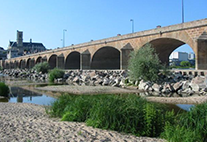CliSAP Workshop: Urban Climate Vulnerability
19 December 2014, by Franziska Neigenfind

Photo: Gemeinfrei - http://creativecommons.org/licenses/by-sa/3.0/
Is urban vulnerability to climate phenomena measurable? If so, how? These questions were the focus of CliSAP’s workshop “Urban climate vulnerability”...
Is urban vulnerability to climate phenomena measurable? If so, how? These questions were the focus of CliSAP’s workshop “Urban climate vulnerability.” The event, held at the end of November, was organized for colleagues from Germany and Italy by Prof. Jürgen Oßenbrügge and Dr. Benjamin Bechtel.
The researchers discussed methods of evaluating vulnerability and the impact of climatic, economic and demographic factors. In a nutshell, vulnerability describes the risk of being affected by natural hazards as well as the susceptibility and adaptive capacity of a system, such as a city. The heat wave in August 2003 is one example of a natural hazard, which cost the lives of several thousand people, mainly in southern and central Europe.
“Urban- and climate research is increasingly focusing attention on the vulnerability of cities,” says Jürgen Oßenbrügge, Head of the CliSAP Research Group “Urban Systems–Test Bed Hamburg.” The reasons for this are the fact that cities in Germany and the rest of Europe are becoming denser and increasing global urbanization. To date there has been no generally accepted concept of vulnerability. The workshop participants discussed methods of evaluating urban vulnerability to climate phenomena. To overcome this, urban climate researchers want to develop computational models for urban areas.
The challenge here is incorporating aspects from very different specialist areas, including climate, building, economics, demographics and sociology. However, many of these factors are not completely understood, and the way they interact is still unclear. Added to this are other parameters such as spread, density, functional structure and the characteristics of the landscape, all of which change at a different pace.
“During the meeting it became clear that there is not just one approach. This means that to start with we have to concentrate on regional case studies,” summarized Bechtel. “These need to be worked on by interdisciplinary teams and include local players.” This would allow experts to first of all estimate the risks for a particular region and then devise suitable adaptation measures. In the long term, such case studies could provide important building blocks for more generally applicable models.
Along with the workshop’s organizers, speakers included Prof. Wilfried Endlicher from the Humboldt Universität zu Berlin, Dr. Hannes Taubenböck from the DLR (the German national aeronautics and space research center), Giedrius Kaveckis, who works at CliSAP and the Center for Earth System Research and Sustainability (CEN) and Dr. Stefan Schneiderbauer from EURAC’s Institute for Applied Remote Sensing in Italy.
CliSAP Research Group "Climate Manifestations and Impacts - Urban Systems - Test Bed Hamburg"
